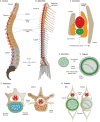Development of a straight vertebrate body axis
- PMID: 33023886
- PMCID: PMC7561478
- DOI: 10.1242/dev.175794
Development of a straight vertebrate body axis
Abstract
The vertebrate body plan is characterized by the presence of a segmented spine along its main axis. Here, we examine the current understanding of how the axial tissues that are formed during embryonic development give rise to the adult spine and summarize recent advances in the field, largely focused on recent studies in zebrafish, with comparisons to amniotes where appropriate. We discuss recent work illuminating the genetics and biological mechanisms mediating extension and straightening of the body axis during development, and highlight open questions. We specifically focus on the processes of notochord development and cerebrospinal fluid physiology, and how defects in those processes may lead to scoliosis.
Keywords: Axis straightening; Notochord; Reissner fiber; Scoliosis; Spine; Vacuoles.
© 2020. Published by The Company of Biologists Ltd.
Conflict of interest statement
Competing interestsThe authors declare no competing or financial interests.
Figures




References
-
- Adams D. S., Keller R. and Koehl M. A. (1990). The mechanics of notochord elongation, straightening and stiffening in the embryo of Xenopus laevis. Development 110, 115-130. - PubMed
-
- Agduhr E. (1922). Über ein zentrales Sinnesorgan bei den Vertebraten. Zeitschrift für Anatomie und Entwicklungsgeschichte 66, 223-360. 10.1007/BF02593586 - DOI
-
- Assaraf E., Blecher R., Heinemann-Yerushalmi L., Krief S., Carmel Vinestock R., Biton I. E., Brumfeld V., Rotkopf R., Avisar E., Agar G. et al. (2020). Piezo2 expressed in proprioceptive neurons is essential for skeletal integrity. Nat. Commun. 11, 3168 10.1038/s41467-020-16971-6 - DOI - PMC - PubMed
Publication types
MeSH terms
Grants and funding
LinkOut - more resources
Full Text Sources

